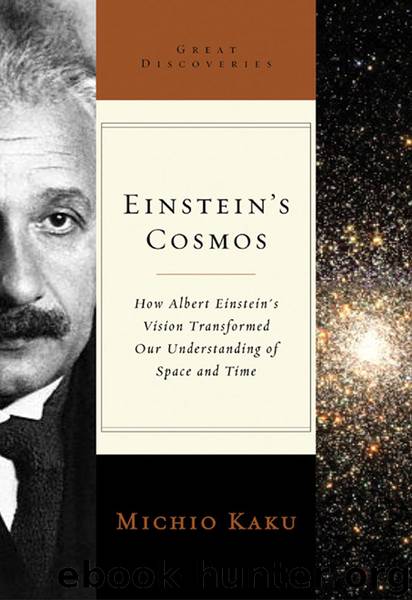Einstein's Cosmos by Michio Kaku

Author:Michio Kaku
Language: eng
Format: epub
Publisher: W. W. Norton & Company
Published: 2004-04-15T16:00:00+00:00
PART III
THE UNFINISHED PICTURE
The Unified Field Theory
CHAPTER 7
Unification and the Quantum Challenge
In 1905, almost as soon as Einstein worked out the special theory of relativity, he began to lose interest in it because he set his sights on bigger game: general relativity. In 1915, the pattern repeated itself. As soon as he finished formulating his theory of gravity, he began to shift his focus to an even more ambitious project: the unified field theory, which would unify his theory of gravity with Maxwell’s theory of electromagnetism. It was supposed to be his masterpiece, as well as the summation of science’s two-thousand-year investigation into the nature of gravity and light. It would give him the ability to “read the Mind of God.”
Einstein was not the first to suggest a relationship between electromagnetism and gravity. Michael Faraday, working at the Royal Institution in London in the nineteenth century, performed some of the first experiments to probe the relationship between these two pervasive forces. He would, for example, drop magnets from the London Bridge and see if their rate of descent differed from that of ordinary rocks. If magnetism interacted with gravity, perhaps the magnetic field might act as a drag on gravity, making the magnets fall at a different rate. He would also drop pieces of metal from the top of a lecture room to a cushion on the floor, trying to see if the descent could induce an electric current in the metal. All his experiments produced negative results. However, he noted, “They do not shake my strong feeling of the existence of a relation between gravity and electricity, though they give no proof that such a relation exists.” Furthermore, Riemann, who founded the theory of curved space in any dimension, believed strongly that both gravity and electromagnetism could be reduced to purely geometric arguments. Unfortunately, he did not have any physical picture or field equations, so his ideas went nowhere.
Einstein once summarized his attitude toward unification by comparing marble and wood. Marble, thought Einstein, described the beautiful world of geometry, in which surfaces warped smoothly and continuously. The universe of stars and galaxies played out their cosmic game on the beautiful marble of space-time. Wood, on the other hand, represented the chaotic world of matter, with its jungle of subatomic particles, its nonsensical rules for the quantum. This wood, like gnarled vines, grows in unpredictable and random ways. New particles being discovered in the atom made the theory of matter quite ugly. Einstein saw the defect in his equations. The fatal flaw was that wood determined the structure of the marble. The amount of bending of space-time was determined by the amount of wood at any point.
Thus, to Einstein, his strategy was clear: to create a theory of pure marble, to eliminate the wood by reformulating it solely in terms of marble. If the wood itself could be shown to be made of marble, then he would have a theory that was purely geometric. For example, a point particle is infinitely tiny, having no extension in space.
Download
This site does not store any files on its server. We only index and link to content provided by other sites. Please contact the content providers to delete copyright contents if any and email us, we'll remove relevant links or contents immediately.
The Complete Stick Figure Physics Tutorials by Allen Sarah(7336)
Secrets of Antigravity Propulsion: Tesla, UFOs, and Classified Aerospace Technology by Ph.D. Paul A. Laviolette(5332)
Thing Explainer by Randall Munroe(3909)
The River of Consciousness by Oliver Sacks(3572)
The Order of Time by Carlo Rovelli(3162)
How To by Randall Munroe(3074)
A Brief History of Time by Stephen Hawking(2991)
I Live in the Future & Here's How It Works by Nick Bilton(2959)
What If?: Serious Scientific Answers to Absurd Hypothetical Questions by Randall Munroe(2667)
The Great Unknown by Marcus du Sautoy(2662)
Midnight in Chernobyl by Adam Higginbotham(2515)
Blockchain: Ultimate Step By Step Guide To Understanding Blockchain Technology, Bitcoin Creation, and the future of Money (Novice to Expert) by Keizer Söze(2467)
Networks: An Introduction by Newman Mark(2382)
The Meaning of it All by Richard Feynman(2318)
Easy Electronics by Charles Platt(2308)
The Tao of Physics by Fritjof Capra(2247)
Midnight in Chernobyl: The Untold Story of the World's Greatest Nuclear Disaster by Adam Higginbotham(2195)
When by Daniel H Pink(2098)
Introducing Relativity by Bruce Bassett(2097)
